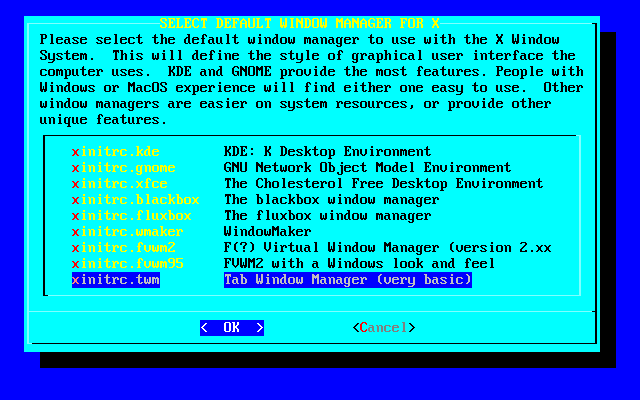6.4 xwmconfig
For years, Unix was used almost exclusively as the operating system for servers, with the exception of high-powered professional workstations. Only the technically inclined were likely to use a Unix-like operating system, and the user interface reflected this fact. GUIs tended to be fairly bare-bones, designed to run a few necessarily graphical applications like CAD programs and image renderers. Most file and system management was conducted at the command line. Various vendors (Sun Microsystems, Silicon Graphics, etc) were selling workstations with an attempt to provide a cohesive “look and feel”, but the wide variety of GUI toolkits in use by developers led inevitably to the dissolution of the desktop's uniformity. A scrollbar might not look the same in two different applications. Menus might appear in different places. Programs would have different buttons and checkboxes. Colors ranged widely, and were generally hard-coded in each toolkit. As long as the users were primarily technical professionals, none of this mattered much.
With the advent of free Unix-like operating systems and the growing number and variety of graphical applications, X has recently gained a wide desktop user base. Most users, of course, are accustomed to the consistent look and feel provided by Microsoft's Windows or Apple's MacOS; the lack of such consistency in X-based applications became a barrier to its wider acceptance. In response, two open source projects have been undertaken: The K Desktop Environment, or KDE, and the GNU Network Object Model Environment, known as GNOME. Each has a wide variety of applications, from taskbars and file managers to games and office suites, written with the same GUI toolkit and tightly integrated to provide a uniform, consistent desktop.
The differences in KDE and GNOME are generally fairly subtle. They each look different from the other, because each uses a different GUI toolkit. KDE is based on the Qt library from Troll Tech AS, while GNOME uses GTK, a toolkit originally developed for The GNU Image Manipulation Program (or The GIMP, for short). As separate projects, KDE and GNOME each have their own designers and programmers, with different development styles and philosophies. The result in each case, however, has been fundamentally the same: a consistent, tightly integrated desktop environment and application collection. The functionality, usability, and sheer prettiness of both KDE and GNOME rival anything available on other operating systems.
The best part, though, is that these advanced desktops are free. This means you can have either or both (yes, at the same time). The choice is yours.
In addition to the GNOME and KDE desktops, Slackware includes a large collection of window managers. Some are designed to emulate other operating systems, some for customization, others for speed. There's quite a variety. Of course you can install as many as you want, play with them all, and decide which you like the most.
To make desktop selection easy, Slackware also includes a program called xwmconfig that can be used to select a desktop or window manager. It is run like so:
% xwmconfig |
You'll be given a list of all the desktops and window managers installed. Just select the one you want from the list. Each user on your system will need to run this program, since different users can use different desktops, and not everyone will want the default one you selected at installation.
Then just start up X, and you're good to go.
